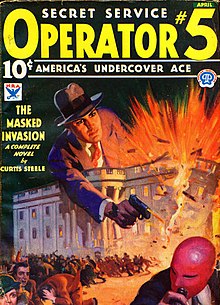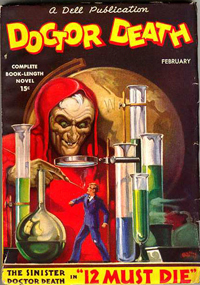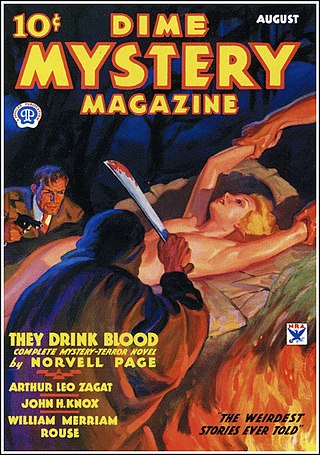
Operator #5 was a pulp magazine published between 1934 and 1939.

Operator #5 was a pulp magazine published between 1934 and 1939.
In 1931 Street & Smith, one of the major pulp magazine publishers, launched The Shadow , the first of the hero pulps. [1] It was an immediate success, and other publications quickly copied the format. [2] Henry Steeger, the owner of pulp publisher Popular Publications, launched two hero pulps in 1933 in response: one was G-8 and His Battle Aces , an air-war pulp, and the other was The Spider , about a crime fighter. [3] The Spider was successful, and Steeger decided to add another hero pulp. Steeger's idea, which he had been mulling over for while, was for a hero who would "single-handedly, or almost, save the nation from complete destruction regularly every month". Popular engaged Frederick C. Davis to write the lead novels; Davis was "one of the most competent writers we had", in Steeger's words. [4]
The lead novels featured Operator #5, whose real name was Jimmy Christopher of the Secret Service. The novels were written by Frederick C. Davis until November 1935, then by Emile C. Tepperman until March 1938, and then Wayne Rogers for the remainder of the run; all three used the house name "Curtis Steele" on all their work for Operator #5.
The plots always involved science fictional ideas such as revival of the dead, sonic rays that could cause panic, rays that damaged the ionosphere, and future war scenarios. Both Tepperman and Rogers embedded their novels in longer story arcs that went on for many issues, involving the invasion of America. In Tepperman's case the invading force was the Purple Empire; in Rogers' case it was the Japanese, and the sequence was unresolved when the magazine was cancelled in 1939, with the Japanese dropping atom bombs on American cities. The short stories that accompanied the lead novel were often spy stories, and included series with repeating characters such as Red Finger and John Vedders, Secret Service Agents whose adventures were chronicled by Arthur Leo Zagat and Frank Gruber, respectively. [5]
Pulp historian Robert Weinberg regards Operator #5 as "the perfect blend of the single-character pulp and the science fiction magazine", praising the early stories by Frederick C. Davis in particular. [5] Pulp historian Wooda Nicholas Carr agrees: "Operator #5 was, and continues to be, regarded as one of the greatest pulp heroes found in the pages behind the gaudy covers that attracted so many". [4]
| Issue data for Operator #5 | ||||||||||||
|---|---|---|---|---|---|---|---|---|---|---|---|---|
| Jan | Feb | Mar | Apr | May | Jun | Jul | Aug | Sep | Oct | Nov | Dec | |
| 1934 | 1/1 | 1/2 | 1/3 | 1/4 | 2/1 | 2/2 | 2/3 | 2/4 | 3/1 | |||
| 1935 | 3/2 | 3/3 | 3/4 | 4/1 | 4/2 | 4/3 | 4/4 | 5/1 | 5/2 | 5/3 | 5/4 | 6/1 |
| 1936 | 6/2 | 6/3 | 6/4 | 7/1 | 7/2 | 7/3 | 7/4 | 8/1 | ||||
| 1937 | 8/1 | 8/2 | 8/3 | 8/4 | 9/1 | 9/2 | 9/3 | 9/4 | ||||
| 1938 | 10/1 | 10/2 | 10/3 | 10/4 | 11/5 | 11/2 | ||||||
| 1939 | 11/3 | 11/4 | 12/1 | 12/2 | 12/3 | 12/4 | ||||||
| Issues of Operator #5, showing volume and issue number. The editor was Rogers Terrill. | ||||||||||||
The publisher was Popular Publications of New York; the editor was Rogers Terrill. It began as a monthly; April 1936 was followed by June/July 1936, inaugurating a bimonthly period that ran to the last issue, November/December 1939, except for a brief monthly period: October/November 1936 was followed by December 1936, January and February 1937, and then by March/April 1937. There were 48 issues, in twelve volumes of four issues; the September/October 1938 issue was mislabelled 11/5 instead of 11/1. The page count began at 128 pages, and dropped to 112 pages with the October 1935 issue. The price was 10 cents through the magazine's run. [6] [5]
Pulp magazines were inexpensive fiction magazines that were published from 1896 until around 1955. The term "pulp" derives from the cheap wood pulp paper on which the magazines were printed. In contrast, magazines printed on higher-quality paper were called "glossies" or "slicks". The typical pulp magazine had 128 pages; it was 7 inches (18 cm) wide by 10 inches (25 cm) high, and 0.5 inches (1.3 cm) thick, with ragged, untrimmed edges. Pulps were the successors to the penny dreadfuls, dime novels, and short-fiction magazines of the 19th century.

The Spider is an American pulp-magazine hero of the 1930s and 1940s. The character was created by publisher Harry Steeger and written by a variety of authors for 118 monthly issues of The Spider from 1933 to 1943. The Spider sold well during the 1930s, and copies are valued by modern pulp magazine collectors. Pulp magazine historian Ed Hulse has stated "Today, hero-pulp fans value The Spider more than any single-character magazine except for The Shadow and Doc Savage."
Popular Publications was one of the largest publishers of pulp magazines during its existence, at one point publishing 42 different titles per month. Company titles included detective, adventure, romance, and Western fiction. They were also known for the several 'weird menace' titles. They also published several pulp hero or character pulps.

Paul Frederick Ernst was an American pulp fiction writer. He is best known as the writer of the original 24 "Avenger" novels, published by Street & Smith under the house name Kenneth Robeson.

Doctor Death was the title of a short-lived pulp science fiction magazine published by Dell Magazines in 1935, as well as the name of the main character featured in that magazine. Doctor Death was an archcriminal who wanted to return the world to a primitive condition and used supernatural tools such as zombies and magic in his plots against humanity. The stories were written by Harold Ward under the pseudonym of "Zorro". Dell may have intended Doctor Death to be a continuation of a character of the same name in All Detective Magazine, also published by Dell.

Secret Agent X was the title of a U.S. pulp magazine published by A. A. Wyn's Ace Magazines, and the name of the main character featured in the magazine. The magazine ran for 41 issues between February 1934 and March 1939.

Famous Fantastic Mysteries was an American science fiction and fantasy pulp magazine published from 1939 to 1953. The editor was Mary Gnaedinger. It was launched by the Munsey Company as a way to reprint the many science fiction and fantasy stories which had appeared over the preceding decades in Munsey magazines such as Argosy. From its first issue, dated September/October 1939, Famous Fantastic Mysteries was an immediate success. Less than a year later, a companion magazine, Fantastic Novels, was launched.

Fantasy was a British pulp science fiction magazine which published three issues in London between 1938 and 1939. The editor was T. Stanhope Sprigg; when the war started, he enlisted in the RAF and the magazine was closed down. The publisher, George Newnes Ltd, paid respectable rates, and as a result Sprigg was able to obtain some good quality material, including stories by John Wyndham, Eric Frank Russell, and John Russell Fearn.

Captain Future was a science fiction pulp magazine launched in 1940 by Better Publications, and edited initially by Mort Weisinger. It featured the adventures of Captain Future, a super-scientist whose real name was Curt Newton, in every issue. All but two of the novels in the magazine were written by Edmond Hamilton; the other two were by Joseph Samachson. The magazine also published other stories that had nothing to do with the title character, including Fredric Brown's first science fiction sale, "Not Yet the End". Captain Future published unabashed space opera, and was, in the words of science fiction historian Mike Ashley, "perhaps the most juvenile" of the science fiction pulps to appear in the early years of World War II. Wartime paper shortages eventually led to the magazine's cancellation: the last issue was dated Spring 1944.

Doc Savage was an American pulp magazine that was published from 1933 to 1949 by Street & Smith. It was launched as a follow-up to the success of The Shadow, a magazine Street & Smith had started in 1931, based around a single character. Doc Savage's lead character, Clark Savage, was a scientist and adventurer, rather than purely a detective. Lester Dent was hired to write the lead novels, almost all of which were published under the house name "Kenneth Robeson". A few dozen novels were ghost-written by other writers, hired either by Dent or by Street & Smith. The magazine was successful, but was shut down in 1949 as part of Street & Smith's decision to abandon the pulp magazine field completely.

Flash Gordon Strange Adventure Magazine was a pulp magazine which was launched in December 1936. It was published by Harold Hersey, and was an attempt to cash in on the growing comics boom, and the popularity of the Flash Gordon comic strip in particular. The magazine contained a novel about Flash Gordon and three unrelated stories; there were also eight full-page color illustrations. The quality of both the artwork and the fiction was low, and the magazine saw only a single issue. It is now extremely rare.

War Birds was a pulp magazine published by Dell from 1928 to 1937. It was the first pulp to focus on stories of war in the air, and soon had competitors. A series featuring fictional Irishman Terence X. O'Leary, which had started in other magazines, began to feature in War Birds in 1933, and in 1935 the magazine changed its name to Terence X. O'Leary's War Birds for three issues. In these issues the setting for stories about O'Leary changed from World War I to the near future; when the title changed back to War Birds later that year, the fiction reverted to ordinary aviation war stories for its last nine issues, including one final O'Leary story. The magazine's editors included Harry Steeger and Carson W. Mowre.

Ace Mystery was a weird menace pulp magazine which published three issues starting in 1936, followed by two more under the title Detective Romances.

The Spider was an American pulp magazine published by Popular Publications from 1933 to 1943. Every issue included a lead novel featuring The Spider, a heroic crime-fighter. The magazine was intended as a rival to Street & Smith's The Shadow and Standard Magazine's The Phantom Detective, which also featured crime-fighting heroes. The novels in the first two issues were written by R. T. M. Scott; thereafter every lead novel was credited to "Grant Stockbridge", a house name. Norvell Page, a prolific pulp author, wrote most of these; almost all the rest were written by Emile Tepperman and A. H. Bittner. The novel in the final issue was written by Prentice Winchell.

Dime Mystery Magazine was an American pulp magazine published from 1932 to 1950 by Popular Publications. Titled Dime Mystery Book Magazine during its first nine months, it contained ordinary mystery stories, including a full-length novel in each issue, but it was competing with Detective Novels Magazine and Detective Classics, two established magazines from a rival publisher, and failed to sell well. With the October 1933 issue the editorial policy changed, and it began publishing horror stories. Under the new policy, each story's protagonist had to struggle against something that appeared to be supernatural, but would eventually be revealed to have an everyday explanation. The new genre became known as "weird menace" fiction; the publisher, Harry Steeger, was inspired to create the new policy by the gory dramatizations he had seen at the Grand Guignol theater in Paris. Stories based on supernatural events were rare in Dime Mystery, but did occasionally appear.
The Western Raider was an American pulp magazine. The first issue was dated August/September 1938; it was followed by two more issues under that title, publishing Western fiction, and then was changed to a crime fiction pulp for two issues, titled The Octopus and The Scorpion. Both these two issues were named after a supervillain, rather than after a hero who fights crime, as was the case with most such magazines. Norvell Page wrote the lead novels for both the crime fiction issues; the second was rewritten by Ejler Jakobsson, one of the editors, to change the character from The Octopus to The Scorpion.

The Mysterious Wu Fang was a pulp magazine which published seven issues in 1935 and 1936. Sax Rohmer's Fu Manchu, an oriental villain, was a "yellow peril" stereotype, and Popular Publications wanted to take advantage of the public's interest. The author of all seven lead novels was Robert J. Hogan, who was simultaneously writing the novels for G-8 and His Battle Aces, producing 130,000 to 150,000 words per month; Hogan was told not to rewrite, but to deliver his first drafts. The hero of the novels was a man named Val Kildare; other characters included a young assistant to Kildare, who was probably added to attract younger readers. The artist John Richard Flanagan, who had experience illustrating Fu Manchu, was hired, but in the opinion of pulp historian Robert Weinberg, "an imitation was an imitation, and the magazine did not sell well". There were short stories along with the lead novel in each issue, also with a "yellow peril" theme; the authors included Steve Fisher, Frank Gruber, O.B. Meyers, and Frank Beaston. The magazine was cancelled after seven issues in favor of a similar magazine with a different villain: Dr. Yen Sin. According to pulp historian Joseph Lewandowski, the decision to switch titles may have been because Wu Fang was too juvenile, and Dr. Yen Sin was supposed to be more mature.

Captain Zero was an American pulp magazine that published three issues in 1949 and 1950. The lead novels, written by G.T. Fleming-Roberts, featured Lee Allyn, who had been the subject of an experiment with radiation, and as a result was invisible between midnight and dawn. Under the name Captain Zero, Allyn became a vigilante, fighting crime at night. Allyn had no other superpowers, and the novels were straightforward mysteries in Weinberg's opinion, though pulp historian Robert Sampson considers them to be "complex...[they] pound along with hair-raising incidents..full of twists and high suspense". Captain Zero was the last crime-fighter hero magazine to be launched in the pulp era, ending an era that had begun with The Shadow in 1931. There was room in the magazine for only one or two short stories along with the lead novel; these were all straight mystery stories, without the veneer of science fiction of the Captain Zero novels.

G-8 and His Battle Aces was an American air-war pulp magazine published from 1930 to 1944. It was one of the first four magazines launched by Popular Publications when it began operations in 1930, and first appeared for just over two years under the title Battle Aces. The success of Street & Smith's The Shadow, a hero pulp, led Popular to follow suit in 1933 by relaunching Battle Aces as a hero pulp: the new title was G-8 and His Battle Aces, and the hero, G-8, was a top pilot and a spy. Robert J. Hogan wrote the lead novels for all the G-8 stories, which were set in World War I. Hogan's plots featured the Germans threatening the Allied forces with extraordinary or fantastic schemes, such as giant bats, zombies, and Martians. He often contributed stories to the magazines as well as the lead novel, though not all the short stories were by him. The cover illustrations, by Frederick Blakeslee, were noted for their fidelity to actual planes flown in World War I.

Battle Birds was an American air-war pulp magazine, published by Popular Publications. It was launched at the end of 1932, but did not sell well, and in 1934 the publisher turned it into an air-war hero pulp titled Dusty Ayres and His Battle Birds. Robert Sidney Bowen, an established pulp writer, provided the lead novel each month, and also wrote the short stories that filled out the issue. Bowen's stories were set in the future, with the United States menaced by an Asian empire called the Black Invaders. The change was not successful enough to be extended beyond the initial plan of a year, and Bowen wrote a novel in which, unusually for pulp fiction, Dusty Ayres finally defeated the invaders, to end the series. The magazine ceased publication with the July/August 1935 issue. It restarted in 1940, under the original title, Battle Birds, and lasted for another four years. All the cover art was painted by Frederick Blakeslee.